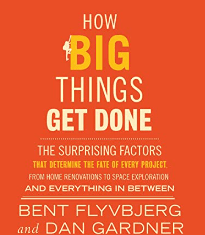We’ve heard the old adage, “Don’t judge a book by its cover,” this is a textbook case (wordplay intended) affirming the truths in this old maxim. First, the book title appears enormous with a qualifying tagline to make it less daunting: “How Big Things Get Done: The Surprising Factors That Determine the Fate of Every Project, from Home Renovations to Space Exploration and Everything in Between.”
In addition to the “BIG” title, the book appeared mammoth to me as I’ve read other books by these same authors, but never this collaboration: Dan Gardner first impressed me with a book he co-authored with Philip Tetlock called “Superforecasting: The Art and Science of Prediction” where they tackle some incredibly tough concepts. I also highly recommend reading Superforecasting to unpack the decision-making process. Dan’s credentials as a journalist are fantastic, and his writing style deconstructs complex ideas into modular examples that help build us toward a more significant, more intricate outcome. Dan has made a writing career by analyzing what leads to good decisions, and co-authoring with Bent Flyvbjerg is topping that list.
I looked forward to reading Dan’s collaboration with Bent Flyvbjerg, the First BT Professor and Inaugural Chair of Major Programme Management at Oxford University’s Said Business School. Flyvbjerg is a heavyweight in project management who has authored many academic papers and is a best-selling author in his own right. His previous works were often more on the technical side for professionals outside of the project management sector.
“Try, learn, again. Whatever the project or the technology, it’s the most effective path to a plan that delivers.” 1
While the book is filled with many examples, insights, and words of wisdom, I wish I’d seen this quote as an encouragement to try this book, which sat on my shelf for nearly a year and almost landed on my “Someday-Maybe” stack of books. Please don’t delay in reading this book like I did.
How Big Things Get Done is easy to read and full of stories which are much easier to relate to than numbers. As an experienced project professional, I found the absence of numbers and constant reference to a growing database of projects rather curious. My experience with projects and project databases over time is that they are often very difficult to compare. Therefore, I believe that the real numbers back up the facts presented.
Surprisingly, nearly a third of the book is dedicated to reference material, which, while typically overlooked, offers a treasure trove to a curious mind. I must have spent hours referencing the citations and going down further rabbit holes. The appendices, particularly Appendix A, prove invaluable, offering practical insights that have already demonstrated value in professional discussions.
As an experienced capital projects professional, I found the book’s insights and experiences deeply relatable. Its readability and depth make it a rare find in the genre and a book I look forward to revisiting—a true exception to my “one-read-only” rule.
UP NEXT
- Simple Example of a Statement of Work
- What Makes a Good SoW?
- The Simplicity of a Responsibilities Matrix
- Thoughts About Angie’s List
Written by John F. Gravel
1) Flyvbjerg, Bent; Gardner, Dan. How Big Things Get Done: The Surprising Factors That Determine the Fate of Every Project, from Home Renovations to Space Exploration and Everything In Between (p. 79). Crown. Kindle Edition.

